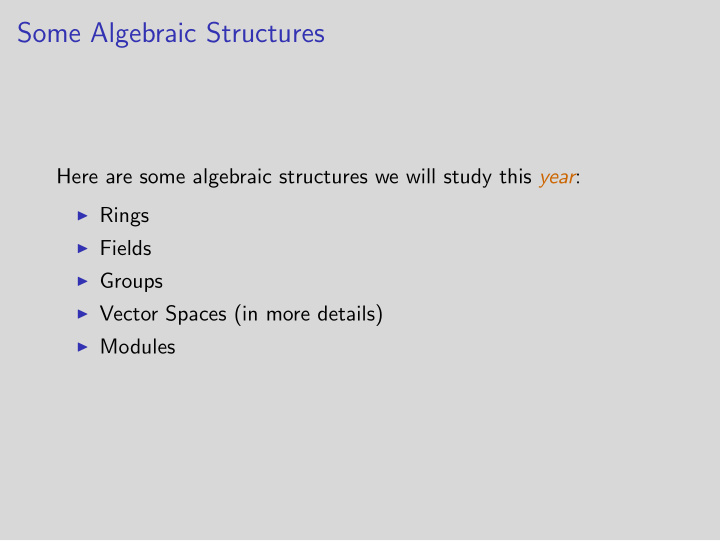



Some Algebraic Structures Here are some algebraic structures we will study this year : ◮ Rings ◮ Fields ◮ Groups ◮ Vector Spaces (in more details) ◮ Modules
Rings Perhaps the most familiar algebraic structure is rings . Rings have two operations: sum and product. [Product here is not scalar product, but product between two elements!] Of course, we ask these operations to satisfy some common properties: associativity, distributive, commutativity [sometimes], etc. Examples are: ◮ Z , Q , R , C ; ◮ R [ X ] [polynomials with variable X and coefficients in R ] where R is one of the examples above [or a commutative ring] ◮ M n ( R ) [ n × n matrices with entries in R ] where R is a one of the examples above [or a commutative ring] On the other hand, N is not a ring, as it lacks “negatives” of elements.
Commutative Rings Note that in the last example [matrices] the multiplication is not commutative! We require the addition to always be commutative, but not multiplication. When multiplication is commutative, we call the ring a commutative ring .
Z / n Z Another important example is Z / n Z : integers modulo n . [This is an example from Math 351.] Remember that in Z / n Z , you perform operations [sum and product] just as in Z , but identify: · · · = − 2 n = − n =0 = n = 2 n = · · · · · · = − 2 n + 1 = − n + 1 =1 = n + 1 = 2 n + 1 = · · · · · · = − 2 n + 2 = − n + 2 =2 = n + 2 = 2 n + 2 = · · · . . . · · · = − n − 1 = − 1 = n − 1 = 2 n − 1 = 3 n − 1 = · · · [ Ex: In Z / 4 Z , 3 + 3 = 6 = 2 and 3 · 3 = 9 = 1.] Note that Z / n Z has n elements.
Fields Another familiar algebraic structure is fields . Basically fields are commutative rings [“with 1”] for which every non-zero element has an inverse : if a � = 0, then there is b [also in the field] such that ab = 1. [So, we can “divide” by non-zero elements.] Examples are Q , R , C . [Note that Z , R [ X ], M n ( R ) are not fields.] Another example is F ( X ), which is the set of all rational functions [i.e., quotient of polynomials, with non-zero denominator] with coefficients in some field F . Finally Z / p Z is a field if [and only if] p is prime .
Vector Spaces Vector Spaces are the structures studied on Math 251: a set with two operations, sum and scalar multiplication. [You multiply an element of the vector space by a scalar, not by another element of the vector space.] In Math 251 scalars were real numbers, but more generally scalars can be elements of any field [as above], such as C , Q , Z / 7 Z , etc. In Math 251 you’ve seen diagonalization of matrices. You’ve seen that it is not always possible! One of the main topics will be to find out the “next best thing(s)”: rational and Jordan canonical forms .
Modules Modules are like vector spaces, except the “scalars” are not in a field, but in a ring . This makes things much more complicated, especially if the ring is non-commutative. We will deal only very briefly with modules and only over [a special case of] commutative rings. We will only deal with them because they give a “natural” way to prove of the canonical forms [for vector spaces] results.
Algebras Algebras are modules [or vector spaces] which area also rings. Thus, we have sum and both multiplication and scalar multiplication. The main examples are: ◮ R [ X ] [polynomials with coefficients in R and variable X ]; ◮ M n ( R ) [ n × n matrices with entries in R ]; where R is a commutative ring [and the scalars are the elements of R ]. We will likely not deal with algebras [at least explicitly] in this course.
Recommend
More recommend